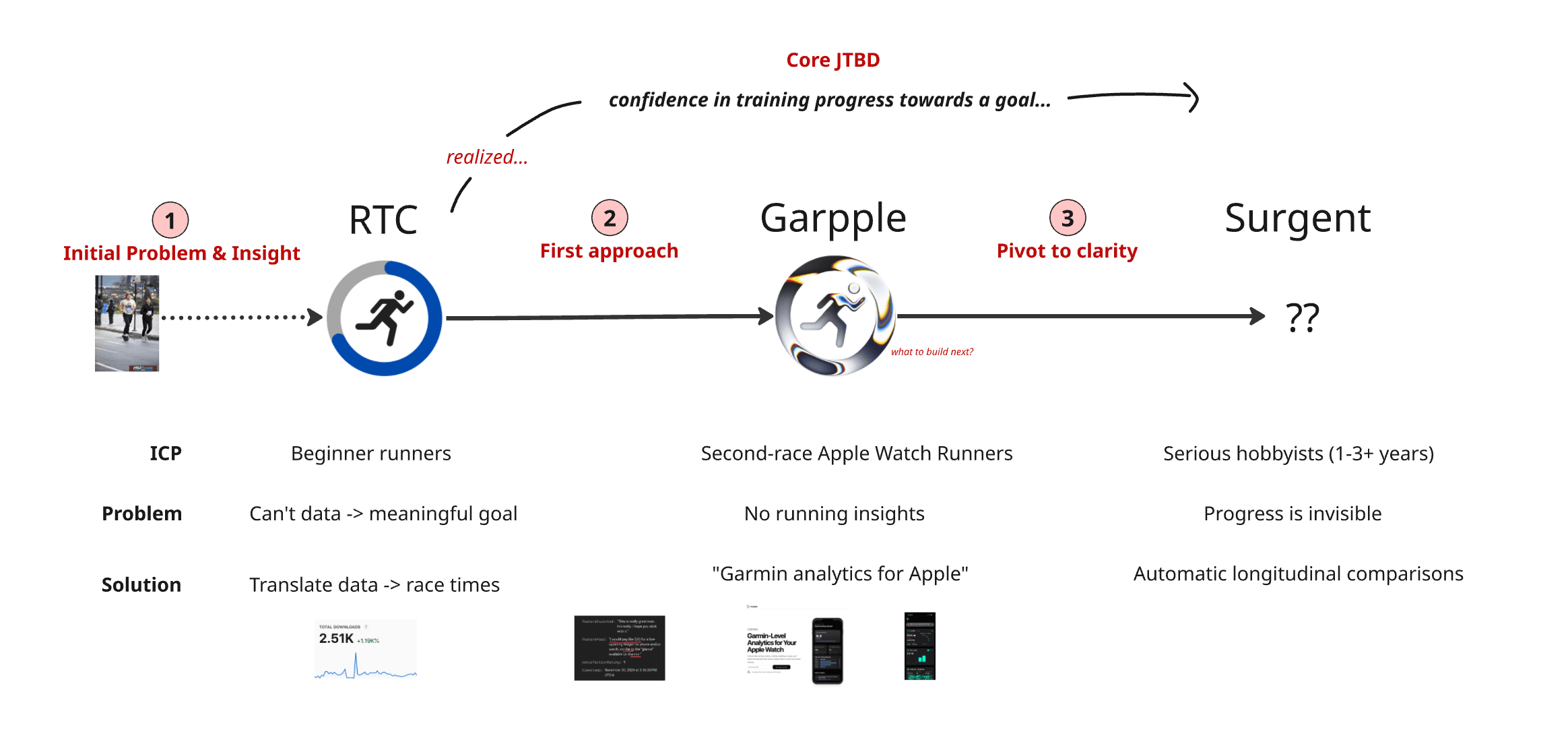
The Garpple Story: From Race Calculator to Progress Companion
Act 1: The Initial Insight (RTC)
I saw: As a newly-serious runner training for my first race, I had months of Apple Watch data but no idea what it meant for my goal race times. I'd open my workout app, see numbers, and wonder "Can I break 1:45 in the half?" Every online race calculator required manual entry of paces I'd have to dig up and guess at. It felt unreliable and disconnected from my actual training.
I realized: There was a clear gap in the market for Apple Watch runners who wanted confidence in achievable goal times based on their real running data - not generic formulas or manual guesswork.
I did: Used AI to build Race Time Calculator - a single-feature app that pulled your actual workout data and translated it into race predictions. No manual entry. No guessing. Just "here's what your training says you can do."
I learned: The product resonated immediately. 200 downloads in the first few months. People wanted this. But more importantly, I'd built something beyond a useful tool - I'd created a vessel to listen to runners who clearly cared about understanding their training data better.
Act 2: The First Pivot (Garpple - "Garmin for Apple")
I saw: In-app feedback and NPS scores revealed a deeper job-to-be-done. Users weren't just asking "what can I race?" - they were asking for confidence in their training progress toward a goal. The feedback kept asking for more: "Can you show recovery metrics?" "What about training load?" "I want to see my fitness trends."
I realized: The race calculator was addressing a surface-level question, but the underlying need was confidence in training progress. The clear market positioning emerged: "Garmin analytics for Apple Watch" - a proven gap that was easy to understand and communicate.
I did: Created a waitlist to validate demand before building. Asked: "What running insights are you missing from your Apple Watch?" The response was overwhelming - 181 signups. I reviewed every request to prioritize the initial build and started working on Garpple alpha with performance and recovery metrics.
I learned: I got muddled. People were asking for everything - prescriptive training advice, coaching insights, workout recommendations. The stated preferences were all over the place, and I was trying to solve too many problems at once. I was building "Garmin for Apple" based on what people said they wanted, but something felt off.
Act 3: The Critical Pivot (Progress Tracking)
I saw: The breakthrough came when I compared two datasets:
- Waitlist feedback (before people had the app): Lots of requests for coaching, prescriptive insights, "tell me what to do"
- In-app feedback (after people were actually using it): Almost no one asked for prescriptive stuff. Instead: "Can you compare this run to similar runs from last month?" "Show me if I'm actually getting faster over time." "I can't tell if my training is working."
I realized: Stated preferences ≠ Revealed preferences.
When grounded in their actual running problems - not hypothetically thinking about what might be useful - users revealed what they truly needed: longitudinal comparison analytics to see progress over time. Not surface-level metrics they wouldn't act on. Not prescriptive advice they'd ignore and feel guilty about. Just evidence that their training was working.
I validated: To confirm this wasn't just selection bias, I:
- Talked to runners via email, text, Reddit (both Garmin and Apple Watch users)
- Reviewed HealthFit's 353 App Store reviews - the closest competitor in the space
- Found the pattern: 4-star reviews consistently mentioned "great data BUT I can't tell if I'm improving" and 20% of feedback explicitly mentioned wanting to track progress/improvement over time
The same problem appeared across multiple data sources. This was real.
I clarified: The real solution wasn't "Garmin for Apple" (more metrics). The real solution was:
- How: "See progress over time" through automatic longitudinal comparisons
- Why: Build confidence that training is working
- For whom: Serious hobby runners (1-3+ years experience) who train consistently but struggle to see improvement between races
I did: Got crystal clear on the new ICP, mission, and thesis. Redesigned the entire app around this core insight: Show runners evidence of progress they can't see elsewhere - so they have confidence their training is working, even between races.
The Journey in One Sentence
Race Time Calculator taught me what people said they wanted. Garpple taught me what people actually needed when using the app. And that difference - between stated and revealed preferences - became the foundation for building something that solves a real, poorly-addressed problem: making invisible progress visible.
Key Learnings That Shaped the Product
- Build to listen, not just to solve: RTC wasn't just a tool - it was my entry point into understanding serious runners' deeper needs
- Trust revealed over stated preferences: What people ask for before using your product ≠ what they need when actually using it
- Pattern validation across data sources: The same problem showing up in waitlist feedback, in-app usage, and competitor reviews = real opportunity
- Narrow positioning beats broad features: "Progress tracking for consistent runners" > "Garmin for Apple with everything"
- Founder-problem fit matters: I'm building this because I live this problem - and that authenticity shows in every design decision